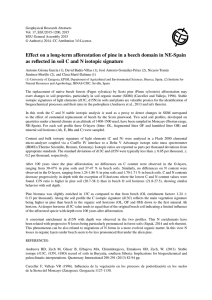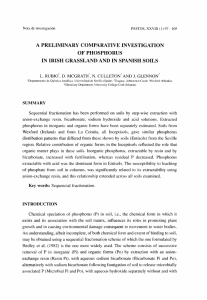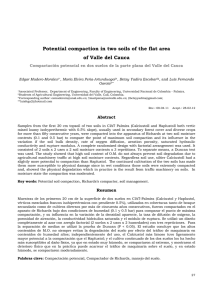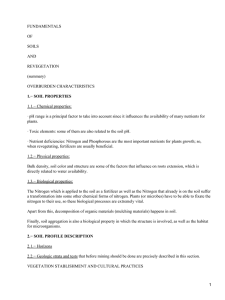Buried soils of floodplains and paleoenvironmental changes in the
Anuncio
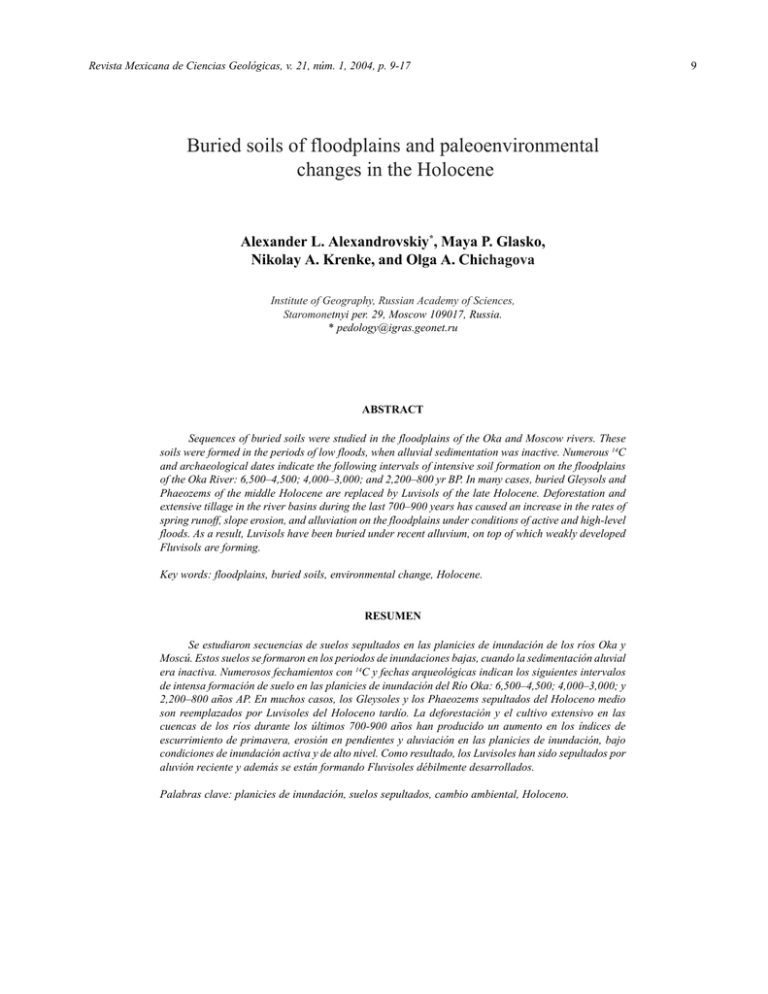
Revista Mexicana de Ciencias Buried Geológicas, soils of v.floodplains 21, núm. 1,and 2004, paleoenvironmental p. 9-17 changes in the Holocene Buried soils of floodplains and paleoenvironmental changes in the Holocene Alexander L. Alexandrovskiy*, Maya P. Glasko, Nikolay A. Krenke, and Olga A. Chichagova Institute of Geography, Russian Academy of Sciences, Staromonetnyi per. 29, Moscow 109017, Russia. * [email protected] ABSTRACT Sequences of buried soils were studied in the floodplains of the Oka and Moscow rivers. These soils were formed in the periods of low floods, when alluvial sedimentation was inactive. Numerous 14C and archaeological dates indicate the following intervals of intensive soil formation on the floodplains of the Oka River: 6,500–4,500; 4,000–3,000; and 2,200–800 yr BP. In many cases, buried Gleysols and Phaeozems of the middle Holocene are replaced by Luvisols of the late Holocene. Deforestation and extensive tillage in the river basins during the last 700–900 years has caused an increase in the rates of spring runoff, slope erosion, and alluviation on the floodplains under conditions of active and high-level floods. As a result, Luvisols have been buried under recent alluvium, on top of which weakly developed Fluvisols are forming. Key words: floodplains, buried soils, environmental change, Holocene. RESUMEN Se estudiaron secuencias de suelos sepultados en las planicies de inundación de los ríos Oka y Moscú. Estos suelos se formaron en los periodos de inundaciones bajas, cuando la sedimentación aluvial era inactiva. Numerosos fechamientos con 14C y fechas arqueológicas indican los siguientes intervalos de intensa formación de suelo en las planicies de inundación del Río Oka: 6,500–4,500; 4,000–3,000; y 2,200–800 años AP. En muchos casos, los Gleysoles y los Phaeozems sepultados del Holoceno medio son reemplazados por Luvisoles del Holoceno tardío. La deforestación y el cultivo extensivo en las cuencas de los ríos durante los últimos 700-900 años han producido un aumento en los índices de escurrimiento de primavera, erosión en pendientes y aluviación en las planicies de inundación, bajo condiciones de inundación activa y de alto nivel. Como resultado, los Luvisoles han sido sepultados por aluvión reciente y además se están formando Fluvisoles débilmente desarrollados. Palabras clave: planicies de inundación, suelos sepultados, cambio ambiental, Holoceno. 9 10 Alexandrovskiy et al. INTRODUCTION Soils of floodplains reflect in their profiles the character of environmental changes and represent a record of alternating processes of alluviation and pedogenesis; the character of pedogenic features in the sequence of buried soils is also subjected to certain alterations. Sequences of buried soils are widespread in the thick alluvial deposits of floodplains in the Russian Plain, as well as in many other plains regions of the world (Voropai and Kunitsa, 1972; Alexandrovskiy et al., 1987; Mandel, 1992; Levis and Illgner, 1998; Yamskikh, 1998). In the central part of the Russian Plain, these sequences have been studied in the floodplains of many rivers, including Volga, Oka, Dnieper, and Seim, among others (Sycheva and Usyanov, 1987; Sycheva, 2000; Alexandrovskiy et al., 2000). The research problems concerning the stratigraphy of floodplain deposits and the age of buried soils are of particular interest to many scientists including us. The beginning of the development of soil–alluvium sequences in floodplains of the Russian plain and in many other regions (Mandel, 1992) dates back to the late Pleistocene–early Holocene. Buried soils are usually confined to loamy and, less frequently, sandy facies of floodplain alluvium; they were formed in the periods of inactive sedimentation and often enclose the remains of ancient settlements (Glasko, 1983). The reasons for the repeated alternation of stages dominated by alluviation or pedogenesis are of great interest to the scientific community (Ferring, 1992). Of particular interest are the unsolved relationships between the duration and rates of pedogensis and alluviation in floodplains. The presence of buried soil sequences poses a problem of the relationship between syngenetic (synchronous to sediment accumulation) and epigenetic soil formation. It is also interesting to assess the degree of preservation of buried soils as dependent on the degree of their development and the age and conditions of burial. The genesis of buried soils as related to the propagation of forest vegetation on the floodplains also deserves special study. The problems of the genesis of floodplain soils have received considerable attention in Russian pedological literature (Dobrovol’skiy, 1968; Tereshina et al., 1989). Soils of floodplains are subdivided into several groups based on the degree of their development and the type of pedogenesis. It has been shown that poorly developed floodplain soils with distinct alluvial stratification (Soddy stratified soils, Fluvisols) gradually evolve into better-developed soils with some features of floodplain pedogenesis (Soddy and Meadow Alluvial soils, Mollic and Umbric Fluvisols). Then, these soils may transform into well-developed soils that resemble the soils of surrounding interfluves [SoddyPodzolic and Gray Wooded soils (Luvisols), and Chernozems] (Voropai and Kunitsa, 1972). The genesis of Luvisols occurring on the floodplains is of particular interest for many researchers (Elenevskiy, 1936; Vilenskiy, 1955; Dobrovol’skiy, 1968; Ahtyrtsev and Shchetinina, 1975). The development of these soils is usually connected with the propagation of forest vegetation on ancient and high parts of floodplains (Dobrovol’skiy, 1968). Another hypothesis suggests that these soils with bleached eluvial horizons (E) can develop due to eluvial–gley process under no forest vegetation (Akhtyrtsev and Shchetinina, 1975; Tereshina et al., 1989). There is also an opinion that textural differentiation of these soils has a lithogenic origin and is inherited from the pre-Holocene stage of sedimentation on floodplains (Yakusheva, 2002). Solutions to these problems can only be obtained on the basis of multiple researches with application of the methods of paleopedology, radiocarbon dating, geomorphology, and paleobotany (charcoal analysis). We use these methods to study the chronology of pedogenetic events, rates of soil development, probable mechanisms and factors of soil burial, and the main stages of Holocene evolution of floodplains and floodplain soils in the center of the Russian Plain. In this paper, we investigate floodplains in the basin of the Moscow River and middle reaches of the Oka River. Based on geomorphological methods, the ancient landsurfaces of floodplains have been determined. Within these landsurfaces, the soils and archaeological deposits have been observed. Samples for analytical, micromorphological, and paleobotanical analysis, as well as for radiocarbon dating have been collected from the soils and alluvium. MATERIALS AND METHODS The floodplain of the Moscow River is relatively wide (up to 1–2 km) and has a typical ridged topography. The elevation of the main surface above the waterline is about 3–4.5 m; initially, before the construction of dams, it was by 1–1.5 m higher. The floodplain of the Oka River is about 3 km in width, and its relative elevation reaches 7–9 m. Loamy alluvium of the floodplain facies is widespread within the meander belt; this alluvium is underlain by sands of the channel (stream) facies that are exposed to the surface near the stream (Glasko, 1983). Up to four well-developed soil profiles can be distinguished within the thickness of loamy floodplain alluvium in the Moscow and Oka valleys; two or three buried soil profiles are found in the floodplains of the tributaries of Volga, Oka, and Moscow rivers. In the Oka River floodplain, key archeological sites Klimenty and Nikitino are found near the town of Spassk-Ryazan. At the Klimenty site, buried soils correspond to cultural layers of several ancient settlements (from the Neolithic to the late Medieval time) (Efimenko, 1934). Key sites on the Moscow River floodplain are found within the territory of Moscow and nearest suburbs in the districts of Kur’yanovo, Terekhovo, Tushino, and Myakinino (Figure 1). Cultural layers of the Early Iron Age and Medieval time are found Buried soils of floodplains and paleoenvironmental changes in the Holocene Figure 1. Location of studied floodplain sites (•) in the valley of Moscow river: a: floodplain; b: valley. 1: Myakinino; 2: Tushino; 3: Terekhovo; 4: Kuryanovo; 5: Brateyevo. within buried floodplain soils at the sites of Kur’yanovo and Myakinino. Soil age was determined by archaeological methods and radiocarbon dating. The duration of pedogenetic processes and the rate of alluvial sedimentation were judged from data of radiocarbon age, and morphology and thickness of particular alluvial layers. Radiocarbon dates were obtained from humic acids (HA) and charcoal in the Radiocarbon Laboratories of the Institute of Geography (Lab Code IGAN) and Institute of Geology (GIN) of the Russian Academy of Sciences. The calibration of dates was performed with the use of the Groningen calibration program (van der Plicht, 1993), updated with the recommended Intcal-98 dataset (Stuiver et al., 1998). RESULTS Buried floodplain soils have different thickness and degree of development; they also differ by the character of pedogenesis. Along with typical Fluvisols having an A–C profile and distinct alluvial stratification, there are also soils with a well developed humus horizon and are referred to as Phaeozems or Mollic Fluvisols. In conditions of increased groundwater supply (in the hollows within the main surface of the floodplain), Fluvic Gleysols and/or Eutric Fluvisols can be found. Often, buried Luvisols (including Eutric and Albic Luvisols) similar to the soils of neighboring terraces and interfluves are found in the thickest floodplain sediments. 11 In the key section Myakinino, sandy soils are found. Soil II enclosed cultural layers dating back to the Early Iron Age and Medieval time; Soil I contains a cultural layer dating back to the 16–17th century AD (Figures 2 and 3). Upstream, within an oxbow depression, Soil II is represented by four separate soil layers (Figure 2). In some oxbows, soils with typical features of eluvial and illuvial horizons (similar to those in Luvisols and Podzols) can be found. In the key section Kur’yanovo (Figure 3), three soil profiles are distinguished. The uppermost soil profile (Soil I) is represented by immature Luvisol that developed during the last 500–700 years. Soil II is buried at a depth of 1.3 m; this is a well-developed soddy soil with a dark humus horizon (Phaeozem or Mollic Fluvisol). The eluvial horizon is absent. Humic acids from soil II have the following 14C ages: 2,850±70; 2,500±50; 2,000±50 yr BP (IGAN-2083, 2084, 2075). According to 14C dating of charcoal from the surface of Soil II, burial of this soil took place about 900±100 yr BP (GIN-9886). Hence, Soil II was developed in an interval from about 3,000 to 900 years ago. Buried Soil III is less developed; it is classified as a typical Fluvisol. It should be noted that the structural status of Soils II and III is affected by Soil I (Luvisol): both soils have a superimposed blocky prismatic structure. In the key section Terekhovo-7, the upper buried soil is Soil II (Soil I is absent). It is overlain by a 1.6-m-thick layer of stratified alluvium with archaeological materials of the 14th–15th centuries AD. Soil II is classified as a Luvisol. At a depth of 3 m, Soil III (Umbric Fluvisol) is distinguished. The age of this soil dates back to 6,360±100 yr BP (IGAN2088). The analysis of charcoal remains from the Luvisol shows that the trees ash (Fraxinus), oak (Quercus), elm (Ulmus), and alder (Alnus) were present in the floodplain forests. At the key section Tushino, the lowermost buried soil (Soil IV) at a depth of 205–210 cm has an age of 11,780±290 yr BP (IGAN-2319). Two Luvisol profiles can be distinguished above Soil IV. Soil III (165 cm) has an age of 5,460±160 yr BP (IGAN-2320); the age of Soil II (115 cm) is 1,780±80 yr BP (IGAN-2321). The uppermost Soil I is poorly developed (Figure 4). Charcoal remains from elm and birch (Betula) are found in the Luvisol III. In the floodplain of the middle Oka River, some multilayered (from Neolithic until the modern period) settlements are found (Alexandovskiy et al., 1987). Their cultural deposits are mostly confined to buried soils (Figure 4). These soils developed when the plain was not regularly flooded and alluvial sedimentation was inactive. Four main buried soils dated by radiocarbon and archaeological methods were identified in a series of sections through the multilayered floodplain settlements: I: Modern alluvial soil: Fluvisol, 300–0 (100) yr BP; II: Early Iron Age and Early Medieval soil: Luvisol (Gray wooded soil), 2,300–800 yr BP; III: Late Bronze artifacts in alluvial soil: Fluvisol, 12 Alexandrovskiy et al. Figure 2. Moscow river, Myakinino site. 1: Modern (anthropogenic) alluvium, 800-0 B.P.; 2: middle–late Holocene alluvium, 8,000-800 B.P.; 3: late Pleistocene–early Holocene alluvium, >8,000 B.P. 4,000–2,700 yr BP; IV: Neolithic cultural deposit in a dark deep soil: Phaeozem, 6,000–4,500 yr BP. When Soil II (Luvisol) was formed, its profile grew downwards (Bt horizons were developed). Pedogenetic processes affected underlying alluvial deposits (and buried Soils III and IV) causing their compaction and structural changes. The Soil II has the same age (800–2,500 yr BP) in all sections studied. In contrast to older and younger soils, the profile of Soil II has textural differentiation (Luvisol), an E horizon depleted in clay, and in the Bt horizon there are illuvial clay cutans (Alexandrovskiy et al., 2000; Alexandrovskiy, 2002). The rates of alluvial sedimentation calculated from layer thicknesses and dating varied considerably and were notably lower during the formation of Soil II (Luvisol) in the floodplains of the Oka and Moscow Rivers. Soil II developed under forest vegetation. Changes in hydrology of the floodplain led to multiple shifts of human settlements to the elevated positions and back. DISCUSSION Our studies attest to the fact that there are relatively stable surfaces within floodplains in the center of the Russian Plain (as well as in the other plains regions of the world) that have not been affected by river meandering. At least, alluvial sediments that were deposited on these surfaces in the early Holocene have not been destroyed. Stages of alluvium accumulation in valleys have alternated with stages of more active pedogenesis. Models for the development of floodplain soils Sequences of buried soils of different ages and different genetic types are widespread within ancient stable geomorphic parts of floodplains of the Moscow, Oka, and other rivers of the center of the Russian Plain. The reasons for multiple alternations of the stages of alluviation and pedogenesis in the floodplains are still not fully understood. Many authors believe that the main reason for this phenomenon is connected with climate changes and related fluctuations in the height of floods (Glasko, 1983; Sycheva et al., 1992; Mandel, 1992). According to another hypothesis, geomorphic processes of floodplain development are of major importance. Thus, alluvial sedimentation takes place mainly near the stream and is confined to the active meander belt (Ferring, 1992). As a result of active accumulation of alluvium within this belt, the surface of the floodplain and the stream bed rise up. This is followed by the breaking of natural levees and the development of a new stream bed within a relatively low part of the floodplain, where a well-developed soil had previously formed under conditions of low rates of alluvial sedimentation (Figure 5). The former meander belt abandoned by the river becomes an area with low sedimentation rates and active soil development, whereas soil formation along the new stream bed is replaced by the predominant deposition of alluvium. Thus, the development of soils on different parts of a floodplain proceeds asynchronously. The hypothesis of climate-controlled changes in the regimes of alluvial sedimentation and pedogenesis was tested by us using the example of buried soil sequences in the floodplain of the Middle Oka basin (Alexandrovskiy et al., 1987). It was found that the development of corresponding buried soils within different parts of the floodplain proceeded simultaneously. This fact attests to some periodicity (or cyclic pattern; Sycheva and Usyanov, 1987; Sycheva, 2000) in the rates of alluvial sedimentation (and pedogenesis). Continued study of this problem requires the analysis and interpretation of peculiarities of the stratigraphy of floodplain sediments and soils together with chronological data. Buried soils of floodplains and paleoenvironmental changes in the Holocene 13 Figure 3. Floodplain soils and cultural layers in sites Kuryanovo and Myakinino. 1: Modern soils; 2: buried soils; 3: horizon Bt of youngest Soil I. Rate of soil formation and alluviation Soil development in the floodplain depends on the rate of alluvium accumulation (Holliday, 1992). The results of key sites studies in the floodplain of the Moscow River, indicate that the rate of alluviation dictates the degree of soil development and the character of the soil profile. According to our data, when the rate of alluviation exceeds 30 cm/100 years (3 mm/year), well-developed soils cannot be formed; instead, a unit of stratified sediments is produced. Typical Fluvisols with distinct stratification (layering) develop when the rate of alluviation is from 1 to 3 mm/year. When the rate of alluviation is less than 1 mm/year, welldeveloped soils (Mollic Fluvisols, Phaeozems, Chernozems) can be formed. The development of Luvisols can take place when the rate of alluviation is less than 0.3 mm/year. Chronology There are just a few 14C dates for the early and middle Holocene soils in the floodplain of the Moscow River. The most ancient date is 11,780±290 yr BP (Tushino site); this is the oldest (among studied) buried soil in the floodplains of the Russian Plain. Buried soils dating back to 6,300 and 5,460 yt BP (key sites Terekhovo and Tushino) can be correlated to Soil IV of the Klimenty key site on the Oka River floodplain (Alexandrovskiy et al., 1987). However, Soil III from the latter site (3,200–3,800 yr BP) has no analogues in the Moscow River floodplain. In the Subatlantic period of the Holocene, within the time range from 3,000 to 600 yr BP, the water level was relatively low and parts of the floodplain with a relative elevation above 5 m were not flooded (at present, the water level is 1–2 m higher). Soil II developed during this period. This soil can be traced in the key sections of Myakinino, Terekhovo, and Kur’yanovo. In many cases, this soil can be classified as a Luvisol (or it has definite Luvisolic features and can be referred to as a Luvic Fluvisol); its features are typical of the soils developing under forest vegetation. The fact that this soil can be traced in many places at considerable distances from one another supports the hypothesis of climate-controlled soil development rather than the hypothesis explaining the development of buried floodplain soils by geomorphic processes (river meandering and rapid shifts in the position of the main stream). Additional data exists about the synchronous development of corresponding soils in other floodplains within the Russian Plain (Alexandrovskiy et al., 2000). Two main periods of alluviation and soils burial at 300–900 and 4,200–4,700 yr 14 Alexandrovskiy et al. Figure 4. Soils in the floodplains of Oka river and Moscow river, Tushino site. BP and two weakly marked periods at 2,700–3,300 and 6,000–6,500 yr BP have been distinguished. There is evidence of cases of soil burial caused by migration of the river channel together with anthropogenic impacts. As a result, splitting of Soil II (Nikitini and Myakinino sites) and Soil I (Terekhovo site) has been observed. In the 12th to 15th centuries AD, the level of floods became higher and new portions of alluvium were laid on the surface of Soil II. At the end of the 16th century and the beginning of the 17th century, the level of floods became lower and human settlement recommenced in the Myakinino2 site. In this period, the development of Soil I started. It lasted for a relatively short time (maybe less than a century). Then, floods became higher again, and the surface of the floodplain became leveled owing to filling of the depressions with fresh alluvial sediments. However, at the Kur’yanovo site, Soil I continued its development under forest vegetation. The latter lasted for several centuries, so that a texturally differentiated profile with a Bt horizon was formed. Soil genesis Buried soils of floodplains can be classified into several genetic types of soils. Some of them fall into the category of soddy and meadow alluvial soils that are only typical of floodplains. At the same time, there are floodplain buried soils that are very similar to the soils of surrounding terraces and interfluves. Thus, Chernozemic, Gray Forest, Soddy-Podzolic (Luvisolic), and other types of soils have been described on floodplains (Voropai and Kunitsa, 1972; Sycheva and Usyanov, 1987; Alexandrovskiy et al., 2000). In most cases, there is a certain trend of changes in the genetic nature of buried floodplain soils: from Fluvisols and Gleysols in deep layers to automorphic soils (Mollisols, Luvisols) typical of surrounding interfluves. This change in the character of pedogenesis may be conditioned by changes in the relief of the floodplain; they are not necessarily connected with climate changes. Thus, gradual accumulation of alluvium and downcutting of the stream bed results in better drainage of floodplains and substitution of automorphic soils for hydromorphic ones (Figure 6). The most ancient buried soils are found at great depth in the thickness of floodplain deposits; sometimes, their topographic level is just a bit higher than the modern water level in a stream. This attests to the low position of unflooded parts of floodplains in the past and, probably, to the lower water level in the stream and lower river-bed position in general. Soils that develop under herbaceous vegetation Buried soils of floodplains and paleoenvironmental changes in the Holocene 15 Figure 5. Model of floodplain deposition and soil formation after Ferring (1992). (Fluvisols, Gleysols, Phaeozems, etc.) usually have a relatively shallow profile represented by the A1 horizon underlain by poorly developed BC and C horizons, often with gley features. Soils that develop under forest vegetation from loamy alluvium have a thicker profile consisting of the humus-accumulative, eluvial, and illuvial horizons. Alluvial stratification within these horizons is often destroyed almost completely. Illuviation and structural reorganization of the soil matrix affects considerable the thickness of alluvial sediments, including previously buried soils. Thus, the development of a forest soil often leads to the destruction of previously buried soils. Particle-size distribution data obtained by us demonstrate certain tendencies in the texture of separate layers of alluvial deposits (Yakusheva, 2002; Alexandrovskiy, 2002). Usually, the content of the clay fraction increases from the bottom to the top of particular layers of sediments indicating changes in the regime of sedimentation. The maximum content of clay is usually observed in the topmost part of the sediment thickness. However, in Luvisols, this maximum is not pronounced, as their upper horizons are subjected to eluviation. Buried Luvisols that can be found on ancient parts of floodplains are indicative of the absence of high floods in certain periods of the floodplain development. In these periods, these parts functioned as river terraces not subjected to floods. Periodically, these periods could be replaced by relatively short periods of active alluviation accompanied by the development of immature Fluvisols. After the cessation of active alluviation, further soil evolution under forest vegetation led to the transformation of these Fluvisols into Luvisols. CONCLUSIONS In the floodplains of the Moscow and Oka rivers, buried soils of different ages and genesis have been discovered. Weakly developed buried soils that can be classified as Fluvisols are found within relatively recent parts of the floodplains. Along with these geomorphic positions, there are widespread areas of ancient and stable floodplain surfaces. In these areas, a series of well developed buried soils have been described. The oldest of these buried soils has a pre-Holocene age (Alleröd) and is classified as a Cryosol. Buried soils of the early and middle Holocene are usually represented by Phaeozems or welldeveloped Fluvisols. Buried soils of the late Holocene in the studied pits belong to the group of Luvisols. This attests to forest vegetation replacing the meadow or meadowsteppe vegetation of the early Holocene. The formation of well-developed Luvisols on floodplains corresponded to 16 Alexandrovskiy et al. Figure 6. Influence of aggradation, channel formation, and drainage changes on pedogenesis in the bottom of a valley. the periods of complete or virtually complete cessation of floods and alluviation. In other words, in these periods floodplains (or their parts) developed in the regime of nonflooded terraces. Along with local phenomena of soil burial related to various local geomorphological processes, there were also periods of active burial of floodplain soils within vast regions. These periods took place at about 8,000; 6,500; 4,500; 3,000; and 800–250 yr BP. As a rule, buried Luvisols are overlain by relatively recent (<1,000 years) stratified alluvium in which the profiles of weakly developed Fluvisols are identified. The formation of recent alluvial sediments on the floodplains was enhanced by anthropogenic loads on the environment. As a result of forest cutting on the interfluves and extensive soil plowing on slopes, the rates of snowmelt discharge and soil erosion have increased significantly with a corresponding increase in the height of floods and alluviation intensity within floodplains. REFERENCES Akhtyrtsev, B.P., Shchetinina, A.S., 1975, Floodplain soils and land use (in russian): Saransk, 44–48. Alexandrovskiy, A.L., 2002, Soil evolution of Eastern Europe in Holocene: Moscow, Russian Academy of Science, Doctoral Thesis (authors abstract), 48 p. Alexandrovskiy, A.L., Glasko, M.P., Folomeev, B.A., 1987, Geoarchaeology studies of floodplain buried soils as a geochronological levels of second half of Holocene (Middle Oka river) (in russian): Bulleten Komissii po izucheniyu Chetvertichnogo perioda, 56, 123–128. Alexandrovskiy, A.L., Glasko, M.P., Sedov, S.N., Folomeev, B.A., Krenke, N.A., Chichagova, O.A., Kuznetsova, E.A., 2000, Buried floodplain soils as evidences of the Holocene environmental Changes in Eastern Europe: GeoLines, 11, 51–52. Dobrovol’skiy, G.V., 1968, Soils of floodplains in the Central Russian plain (in russian): Moscow, Izdatel’stvo Moskovskogo Gosudarstvennogo Universiteta (Moscow Lomonosov University Press), 296 p. Efimenko, P.P., 1934, Settlements of the Bronze Age discovered in the floodplain of the Don River near the village of Kostyonki (in russian): Problems of Precapitalistic Societies, 5. Elenevskiy, R.A., 1936, Problems of the study and development of floodplains (in russian): Moscow, Russian Academy of Agriculture Sciences Press, 153 p. Ferring, C.R., 1992, Alluvial Pedology and Geoarchaeological Research, in Holliday, V.T. (ed.), Soils in Archaeology; Landscape Evolution and Human Occupation: Washington-London, Smithsonian Institution Press, 1–39. Glasko, M.P., 1983, Analysis of factors determining of intensity of alluviation on floodplain of Middle Oka in the Middle-Late Holocene (in russian): Izvestiya, Akademii Nauk SSSR (USSR Academy of Sciences), serie Geography, 5, 66–75. Holliday, V.T (ed.), 1992. Soils in Archaeology; Landscape Evolution and Human Occupation: Washington-London, Smithsonian Institution Press, 254 p. Levis, C.A., Illgner, P.M., 1998, Fluvial conditions during the Holocene as evidenced by alluvial sediments from above Howison’s Port, near Grahamstown, South Africa: Transactions of the Royal Society of South Africa, 53 (1), 53–67. Mandel, R.D., 1992, Soils and Holocene landscapes evolution in central and southwestern Kansas; implications for archaeological research, in Holliday, V.T. (ed.), Soils in Archaeology: Landscape Evolution and Human Occupation: Washington-London, Smithsonian Institution Press, 41–100. Stuiver, M., Reimer, P.J., Bard, E., Beck, J.W., Burr, G.S., Hughen, K.A., Kromer, B., McCormac, F.G., van der Plicht, J., Spurk, M., 1998, INTCAL98 Radiocarbon age calibration 24,000–0 cal BP: Radiocarbon, 40, 1041–1083. Sycheva, S.A., 2000, Long-term Holocene fluctuations of rivers in Russian Plain according to paleosol and archaeological data, in Proceedings of the Fourth International Meeting on Global Continental Palaeohydrology GLOCOPH 2000: Moscow, Institute of Geography, Russian Academy of Sciences, 62–64. Sycheva, S.A., Usyanov, A.A., 1987, Dynamic of water level in the Tuskar River; Soil and archaeological data; Investigation and optimization of water resources of Kursk region (in russian): Kursk, MFGO Press, 75–82. Sycheva, S.A., Chichagova, O.A., Dayneko, E.K., 1992, Ancient stage of soil erosion on Srednerusskaya upland (in russian), in Geochronology of the Quaternary: Moscow, Nauka Press, 34– 40. Tereshina T.V., Balabko P.N., Vostokova, L.B., Patsushenko, N.F., 1989, Genesis of alluvial soils with a bleached horizon (in russian): Pochvovedeniye, 12, 24–34. van der Plicht, J., 1993, The Groningen radiocarbon calibration program: Radiocarbon, 35, 231–237. Buried soils of floodplains and paleoenvironmental changes in the Holocene Vilenskiy, D.G., 1955, Soils of the Oka floodplain, Moscow (in russian): Izdatel’stvo Moskovskogo Gosudarstvennogo Universiteta (Moscow Lomonosov University Press), 67 p. Voropai, L.I., Kunitsa, N.A., 1972, Studies of floodplain buried soils as a method of determination of conformity of landscape development (in russian), in Proceedings of the regional conference Quaternary landscapes of central chernozem region and surrounding territories: Voronezh, Voronezh University Press. Yakusheva, T.E., 2002, Soils with texturally differentiated profiles in the floodplains of the center of the Russian Plain: Moscow, Russian Academy of Science, Doctoral thesis (authors abstract), 24 p. 17 Yamskikh, A.A., 1998, Late Holocene soil formation in the valley of River Yenisei, Central Siberia, Catena, 34, 47–60. Manuscript received: June 11, 2002 Corrected manuscript received: June 26, 2003 Manuscript accepted: July 8, 2003

